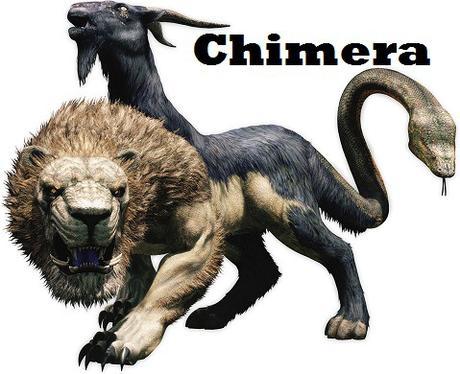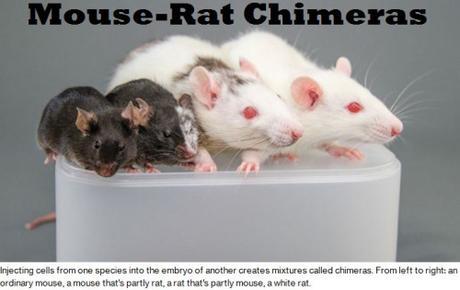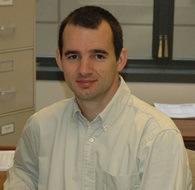In Greek mythology, the Chimera is a monstrous fire-breathing hybrid, composed of the parts of more than one animal.
Usually depicted as a lion, with the head of a goat arising from its back, and a tail that ends with a snake’s head, the Chimera was a sibling of the 3-headed demon-dog Cerberus and the many-headed serpent Hydra, sired by Typhon, the most fearsome monster of Green mythology, and his half-woman half-snake mate, Echidna.

Now, unscrupulous scientists are fashioning even worse than Chimeras — animal-human hybrids — by injecting human stem cells into animals, to grow human organs for eventual transplant.
Antonio Regalado reports for Technology Review, Jan. 6, 2016, that some U.S. research centers are defying the federal government by attempting to grow human tissue inside pigs and sheep, with the goal of creating hearts, livers, or other organs for transplants.
Troubled by the ethics of growing human organs in farm animals because it involves adding human cells to animal embryos in ways that could blur the line between species, in September 2015, the National Institutes of Health (NIH) reversed its earlier policy. The NIH announced it would not support studies involving “human-animal chimeras” until it had reviewed the scientific and social implications more closely. The NIH is concerned that animals’ “cognitive state” could be altered if they ended up with human brain cells.
The NIH action was triggered after it learned that scientists had begun such experiments with support from other funding sources, including from California’s state stem-cell agency. The human-animal mixtures are being created by injecting human stem cells into days-old animal embryos, then gestating the embryos in female livestock.
Based on interviews with three teams, two in California and one in Minnesota, MIT Technology Review estimates that about 20 pregnancies of pig-human or sheep-human chimeras have been established during the last 12 months in the U.S., though so far no scientific paper describing the work has been published, and none of the animals were brought to term.
At presentations made at the NIH’s Maryland campus in November, Juan Carlos Izpisua Belmonte of the Salk Institute showed unpublished data on more than a dozen pig embryo containing human cells. Another researcher, from the University of Minnesota, provided photographs of a 62-day-old pig fetus in which the addition of human cells appeared to have reversed a congenital eye defect.
Recent breakthroughs in stem-cell biology and gene-editing techniques are enabling scientists to modify genes. Scientists can now easily change the DNA in pig or sheep embryos so that they are genetically incapable of forming a specific tissue. Next, human stem cells are introduced into the animal embryos, which then take over the job of forming the missing organ. The human organ would later be harvested from the animal for transplant into a human patient.

Daniel Garry
Daniel Garry, a cardiologist who leads a chimera project at the University of Minnesota, boasts, “We can make an animal without a heart. We have engineered pigs that lack skeletal muscles and blood vessels” which become “viable” and develop properly if a few cells are added from a normal pig embryo. Garry says he’s already melded two pigs in this way.
Garry is among the researchers who say they intend to defy the NIH policy. In November, he was one of 11 authors who published a letter criticizing the agency for creating “a threat to progress” that “casts a shadow of negativity” on their work.
More troubling still is the fact that Garry recently won a $1.4 million grant from the U.S. Army, which funds some biomedical research, to try to grow human hearts in swine. That means one bureaucracy in the federal government, the Army, is working in direct violation of the policy of another bureaucracy, the NIH.
Human-animal chimeras are already widely used in scientific research, including “humanized” mice with a human immune system. Such chimeras are created by adding bits of liver and thymus from an aborted human fetus to a mouse after it is born.
The new line of research goes further by placing human cells into an animal embryo at the very earliest stage, when it is just a clump of a dozen cells in a laboratory dish. This process, called “embryo complementation,” is significant because the human cells can multiply, specialize, and potentially contribute to any part of the animal’s body as it develops.

Hiromitsu Nakauchi
In 2010 in Japan, stem-cell biologist Hiromitsu Nakauchi used the embryo complementation method to generate mice with a pancreas made entirely of rat cells. “If it works as it does in rodents,” he says, “we should be able have a pig with a human organ.”
But Japanese regulators were slow to approve Nakauchi’s chimeras—a “pig man” as critics put it. So in 2013, Nakauchi moved to the U.S. where no federal law restricts the creation of chimeras. Stanford recruited him with the help of a $6 million grant from the California Institute of Regenerative Medicine, a state agency set up a decade ago to bypass political interference from Washington.
To get around the image of chimeras as monsters, Nakauchi is touting how chimeras can produce human organs for transplant, especially if the human iPS cells introduced into an animal are the human patient’s own cells. Nakauchi says the resulting tissue or organ will actually be the patient’s, a kind of perfectly matched replacement part. Desperately ill people on organ waiting lists might someday order a chimera and wait less than a year for their own custom organ to be ready. “I really don’t see much risk to society,” he insists.

Before that can happen, scientists will have to prove that human cells can really multiply and contribute effectively to the bodies of farm animals. That could be challenging since, unlike rats and mice, which are fairly close genetically, humans and pigs last shared an ancestor nearly 90 million years ago.

Pablo Ross
To find out, researchers in 2014 decided to begin impregnating farm animals with human-animal embryos, says Pablo Ross, a veterinarian and developmental biologist at the University of California, Davis, where some of the animals are being housed. Ross says he has transferred about six sets of pig-human embryos into sows in collaboration with the Salk Institute and established another 8 or 10 pregnancies of sheep-human embryos with Nakauchi. Another three dozen pig transfers have taken place outside the U.S., he says.
Ross says the studies at Davis began only after a review by three different ethics committees, and even then, the university decided to be cautious and limit the time the animals would be allowed to develop to just 28 days (a pig is born in 114 days) because “We don’t want to grow them to stages we don’t need to, since that would be more controversial.” At 28 days, the embryonic pig is only half an inch long, though that’s developed enough to check if human cells are contributing to its rudimentary organs.
ethical problems of animal-human hybrids:
1. The hybrid creatures might turn out to be a little too human for comfort, say ending up with human reproductive cells, patches of people hair, or higher intelligence. NIH ethicist David Resnik said during the agency’s November meeting, “We are not near the island of Dr. Moreau, but science moves fast. The specter of an intelligent mouse stuck in a laboratory somewhere screaming ‘I want to get out’ would be very troubling to people.”
Nakauchi began trying to make human-sheep chimeras this year. He says that so far the contribution by human cells to the animals’ bodies appears to be relatively small: “If the extent of human cells is 0.5%, it’s very unlikely to get thinking pigs or standing sheep. But if it’s large, like 40%, then we’d have to do something about that.” For his part, Ross says, “My view is that the contribution of human cells is going to be minimal, maybe 3%, maybe 5%. But what if they contributed to 100% of the brain? What if the embryo that develops is mostly human? It’s something that we don’t expect, but no one has done this experiment, so we can’t rule it out.”
2. Animal-human hybrids might be the perfect vehicles for animal diseases to mutate into forms that threaten humans. The chimera scientists may be creating the conditions for horrible plagues.
3. The use of tissue from aborted human babies as a source for the cells introduced into animal embryos.
4. The callous, heartless, and cruel manipulation and use of God’s creatures for organ cultivation and transplant. Already, pig heart valves are in use for human heart valve replacement. But human-animal hybrids go much further.
“And I brought you into a plentiful land to enjoy its fruits and its good things. But when you came in, you defiled my land and made my heritage an abomination.” -Jeremiah 2:7
P.S. Minutes after this post was published, I received this disheartening email from Steve Quayle:
I’ve written about this for decades — most Christians, and people in general, could care less about this abomination.
~Eowyn

